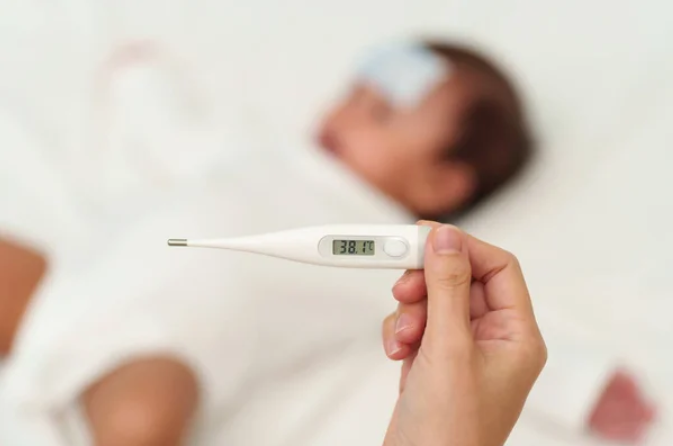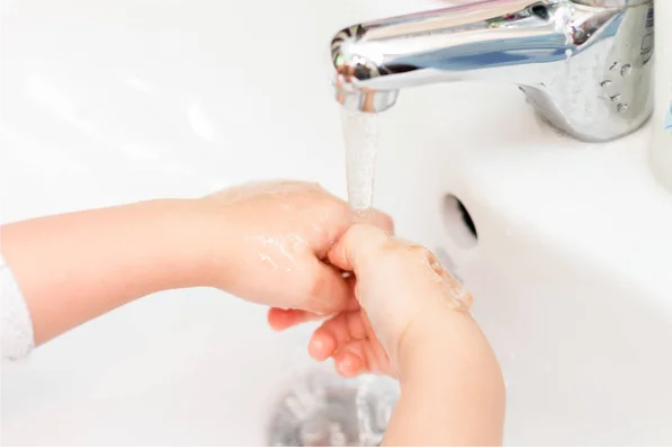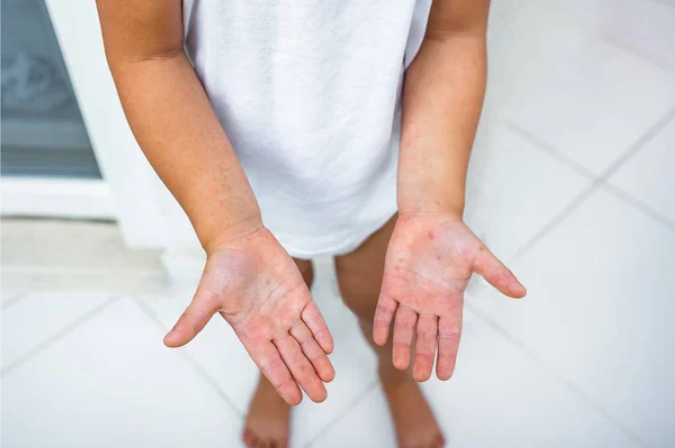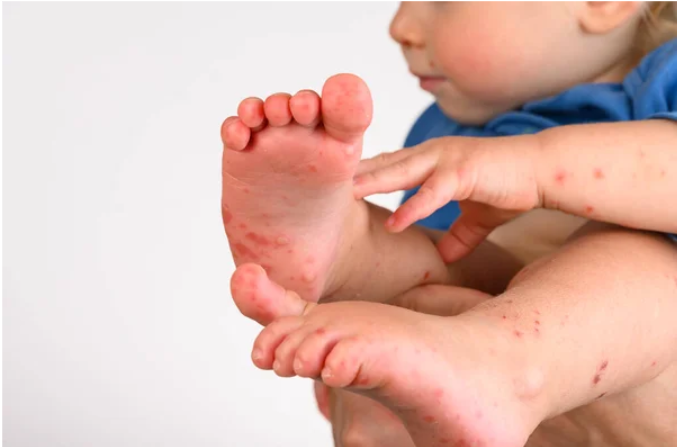Hand, Foot, and Mouth Disease (HFMD) in Children: Everything Parents Must Know
As a parent, discovering unexplained spots on your child can be alarming. Hand, foot, and mouth disease (HFMD) is a common childhood illness that often causes such concerns. We understand the worry and confusion you may be experiencing.
At Entirely Kids Pediatrics, our experienced Frisco pediatrician is committed to guiding you through every childhood health challenge. We’ll provide you with a comprehensive understanding of HFMD, equipping you with the knowledge to confidently care for your child during this uncomfortable time.
Our guide will cover HFMD’s causes, symptoms, home care strategies, and prevention tips. We’ll also clarify when to seek professional medical attention. By the end, you’ll feel empowered to manage HFMD, transforming your initial concern into capable, informed care for your little one.
What is Hand, Foot, and Mouth Disease?
Hand, foot, and mouth disease is a highly contagious viral illness that primarily affects infants and children under the age of 5. It’s characterized by painful sores in the mouth and a rash on the hands and feet. Despite its name, HFMD is not related to the foot-and-mouth disease that affects livestock.
Causes of HFMD
HFMD is caused by viruses belonging to the Enterovirus genus, most commonly the coxsackievirus A16. Other causes of HFMD include enterovirus 71 and various other coxsackieviruses. These viruses spread through close contact with an infected person or exposure to their respiratory droplets, saliva, or fecal matter. Understanding what causes hand, foot, and mouth disease is crucial for preventing its spread.
How Does HFMD Spread?
The viruses that cause HFMD are highly contagious and can spread through various means:
- Respiratory droplets from coughing or sneezing
- Saliva, nasal mucus, or throat discharge
- Fluid from blisters
- Stool
- Contaminated objects or surfaces
It’s important to note that an infected person is most contagious during the first week of illness, but the virus can remain in the body for weeks after symptoms disappear. This is why understanding the causes of HFMD disease is essential for minimizing its transmission. Ensuring consistent primary care for children can help in early detection and management of such illnesses, reducing the risk of spreading the virus.
Symptoms of Hand, Foot, and Mouth Disease

Recognizing the Signs
The signs and symptoms of foot and mouth disease usually appear 3-6 days after exposure to the virus. Common hand, foot, and mouth disease symptoms include:
- Fever
- Sore throat
- Loss of appetite
- Fatigue
- Painful, blister-like sores in the mouth (herpangina)
- A rash on the palms of the hands, soles of the feet, and sometimes the buttocks
These symptoms can be uncomfortable for your little one, but they typically subside within a few days. The mouth sores and rash may last up to 10 days.
The Stages of HFMD
HFMD typically progresses through several stages:
- Incubation period: After exposure to the virus, it can take 3-6 days for symptoms to appear.
- Early symptoms: The first signs of HFMD often include fever, sore throat, and loss of appetite.
- Mouth sores: Painful, blister-like sores (herpangina) develop in the mouth, usually at the back of the throat and on the tongue.
- Rash: A rash consisting of flat or raised red spots appears on the palms of the hands, soles of the feet, and sometimes the buttocks.
- Recovery: Fever and other symptoms usually subside within a few days, while the mouth sores and rash may last up to 10 days.
Understanding these stages can help you anticipate your child’s needs and provide appropriate care throughout the illness.
How is HFMD Diagnosed?
Most doctors can diagnose HFMD based on the characteristic hand, foot, and mouth disease symptoms and a physical examination. In some cases, they may take a throat swab or stool sample to test for the virus, but this is not always necessary.
Treatment Options for Hand, Foot, and Mouth Disease
There is no specific hand, foot, and mouth disease treatment, as the illness must run its course. However, there are ways to alleviate symptoms and keep your child comfortable:
- Over-the-counter pain relievers (acetaminophen or ibuprofen) to reduce fever and discomfort
- Plenty of fluids to prevent dehydration
- Cold or soft foods to soothe mouth sores
- Rest
Home Remedies for HFMD
In addition to the above treatments, some home remedies can help soothe your child’s hand, foot, and mouth disease symptoms:
- Saltwater rinse for mouth sores
- Popsicles or ice chips to numb pain and keep your child hydrated
- Calamine lotion or oatmeal baths to relieve itching from the rash
When to Seek Medical Attention
While most cases of foot and mouth disease in children are mild and resolve on their own, there are times when you should contact your doctor:
- If your child has a fever lasting more than 3 days
- If your child is not drinking enough fluids
- If your child has severe mouth sores that make it difficult to drink
- If your child shows signs of dehydration (dry mouth, sunken eyes, decreased urine output)
- If your child is excessively drowsy or irritable
Preventing the Spread of HFMD

Hygiene and Precautionary Measures
While there is no vaccine to prevent HFMD, there are steps you can take to reduce the risk of infection:
- Wash hands thoroughly with soap and water, especially after changing diapers or using the bathroom
- Disinfect frequently touched surfaces and shared items (toys, doorknobs, etc.)
- Avoid close contact with infected individuals
- Keep children home from school or daycare if they have symptoms
How Long Should Kids Stay Home?
To prevent the spread of hand, foot, and mouth disease in children, they should stay home until they have been fever-free for at least 24 hours and their mouth sores and rash have healed. This can be challenging for working parents, but it’s essential to minimize the risk of infecting others. Understanding illness and infection in children is crucial for implementing effective measures to prevent the spread of contagious diseases like HFMD.
Childcare and School Policies
If your child attends daycare or school, it’s important to notify the staff about your child’s HFMD diagnosis. They may need to take additional precautions to prevent the spread of the virus, such as:
- Increased hand hygiene
- More frequent cleaning and disinfection of surfaces and toys
- Excluding infected children until they are no longer contagious
While it can be inconvenient to keep your child home, it’s crucial to follow the daycare or school’s policies to protect the health of all the children and staff.
Complications of Hand, Foot, and Mouth Disease
While most cases of hand, foot, and mouth disease in children are mild and uncomplicated, in rare instances, the virus can lead to more severe conditions:
- Viral meningitis (inflammation of the membranes covering the brain and spinal cord)
- Encephalitis (inflammation of the brain)
- Paralysis
- Nail loss (temporary)
These complications are more likely to occur with enterovirus 71 infections, which are less common than coxsackievirus A16 infections.
Long-Term Effects of HFMD
Most children recover from HFMD without any long-term effects. However, in very rare cases, enterovirus 71 has been linked to more severe illnesses that can have lasting consequences, such as brain damage or paralysis.
Coping with HFMD as a Parent
Seeing your child suffer from HFMD can be stressful and emotionally draining. It’s essential to take care of yourself during this time, so you can be there for your little one:
- Get enough rest when possible
- Eat a balanced diet
- Ask for help from family and friends
- Take breaks when needed
Remember, your child will likely recover from hand, foot, and mouth disease within a week or two, and life will return to normal.
The Emotional Impact of HFMD on Children
HFMD can be a scary experience for young children, who may not understand why they feel so uncomfortable. To help your child cope:
- Offer plenty of comfort and reassurance
- Explain the illness in simple terms
- Provide distractions, such as favorite books or gentle activities
- Be patient and understanding if your child is more fussy than usual
Your love and support can go a long way in helping your child through this challenging time.
HFMD and Daycare/School Attendance
If your child attends daycare or school, it’s important to notify the staff about your child’s HFMD diagnosis. They may need to take additional precautions to prevent the spread of the virus, such as:
- Increased hand hygiene
- More frequent cleaning and disinfection of surfaces and toys
- Excluding infected children until they are no longer contagious
While it can be inconvenient to keep your child home, it’s crucial to follow the daycare or school’s policies to protect the health of all the children and staff.
The Silver Lining of HFMD

Building Immunity
While HFMD is no picnic, there is a silver lining: once your child has been infected with a specific strain of the virus, they typically develop immunity to that strain. This means that while they may contract hand, foot, and mouth disease again in the future, it’s likely to be caused by a different strain and may result in milder symptoms.
Myth-Busting: Common Misconceptions about HFMD
There are several misconceptions about HFMD that can cause unnecessary worry or confusion for parents. Let’s clear up a few of these myths:
- Myth: HFMD is related to foot-and-mouth disease in animals.
Fact: Despite the similar name, HFMD is a distinct viral illness that only affects humans. It is not related to the foot-and-mouth disease that affects livestock.
- Myth: HFMD is a severe illness that always requires medical attention.
Fact: Most cases of hand, foot, and mouth disease in children are mild and can be managed at home with proper care and symptom relief. However, it’s important to seek medical attention if your child has severe symptoms or signs of dehydration.
- Myth: HFMD only affects young children.
Fact: While HFMD is most common in children under 5, older children and adults can also contract the virus. However, symptoms may be milder in older individuals.
- Myth: There’s a vaccine to prevent HFMD.
Fact: Currently, there is no vaccine available to prevent HFMD. The best way to prevent the spread of the virus is through good hygiene practices and avoiding close contact with infected individuals.
By dispelling these myths, parents can have a clearer understanding of HFMD and make informed decisions about their child’s care.
When to Worry: Recognizing Severe Symptoms

While most cases of hand, foot, and mouth disease in children are mild, it’s essential to be aware of severe symptoms that may require medical attention. Seek immediate medical care if your child experiences:
- High fever (over 103°F or 39.4°C)
- Severe headache
- Stiff neck
- Back pain
- Confusion or disorientation
- Seizures
- Difficulty breathing
- Extreme drowsiness or unresponsiveness
These symptoms may indicate a more serious complication, such as meningitis or encephalitis, and require prompt medical intervention.
Supporting Your Child’s Recovery
As your child recovers from HFMD, there are several ways you can support their healing process:
- Encourage rest: Allow your child plenty of time to rest and recover, as this can help their body fight off the virus more effectively.
- Provide comfort: Offer extra cuddles, soothing words, and favorite comfort items to help your child feel secure and loved during this challenging time.
- Manage symptoms: Use over-the-counter pain relievers, cold or soft foods, and home remedies to alleviate your child’s hand, foot, and mouth disease symptoms and keep them comfortable.
- Stay hydrated: Encourage your child to drink plenty of fluids to prevent dehydration, which can occur if they’re not eating or drinking enough due to mouth pain.
- Be patient: Remember that every child’s recovery is different, and it may take some time for your little one to feel like themselves again. Be patient and supportive throughout the healing process.
By providing a nurturing environment and attending to your child’s physical and emotional needs, you can help them weather the storm of HFMD and emerge stronger on the other side.
Conclusion
Hand, foot, and mouth disease in children is a common viral illness that can cause discomfort and concern for parents. By understanding the causes of HFMD disease, recognizing the signs and symptoms of foot and mouth disease, exploring hand, foot, and mouth disease treatment options, and implementing prevention strategies, you can help your child navigate this condition with minimal complications.
Most cases of HFMD are mild and resolve on their own within a week or two, but being informed allows you to provide the best care and take necessary precautions to prevent its spread. For expert advice and support on managing HFMD and other pediatric concerns, reach out to Entirely Kids Pediatrics. Contact us at 469-425-3600 to ensure your child receives the best possible care.
Top Questions Answered for Concerned Parents
What are the main symptoms of HFMD in children?
The primary symptoms include fever, sore throat, and a rash with small blisters on the hands, feet, and mouth. Some children may also experience loss of appetite and general irritability.
How long does HFMD typically last?
HFMD usually runs its course in 7-10 days. Fever and sore throat typically improve within 3 days, while the rash may last a bit longer.
Is HFMD contagious, and how can I prevent it from spreading?
Yes, HFMD is highly contagious. Prevent spreading by practicing good hygiene, such as frequent handwashing, avoiding close contact with infected individuals, and regularly disinfecting shared surfaces and toys.
Can adults get HFMD from their children?
While less common, adults can contract HFMD from infected children. However, adults often have milder symptoms or may be asymptomatic carriers.
When should I seek medical attention for my child with HFMD?
Consult a pediatrician if your child has a persistent high fever, signs of dehydration, severe mouth sores that prevent drinking, or if symptoms worsen or don’t improve after a week.

